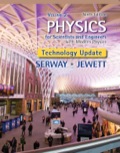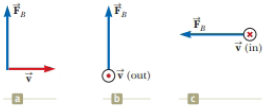
EBK PHYSICS FOR SCIENTISTS AND ENGINEER
9th Edition
ISBN: 9781305804470
Author: Jewett
Publisher: CENGAGE LEARNING - CONSIGNMENT
expand_more
expand_more
format_list_bulleted
Concept explainers
Textbook Question
Chapter 29, Problem 29.3P
Find the direction of the magnetic field acting on a positively charged particle moving in the various situations shown in Figure P28.3 if the direction of the magnetic force acting on it is as indicated.
Figure P28.3

Expert Solution & Answer
Trending nowThis is a popular solution!

Students have asked these similar questions
Using the Experimental Acceleration due to Gravity values from each data table, Data Tables 1, 2, and 3; determine the Standard Deviation, σ, mean, μ, variance, σ2 and the 95% Margin of Error (Confidence Level) Data: Ex. Acc. 1: 12.29 m/s^2. Ex. Acc. 2: 10.86 m/s^2, Ex. Acc. 3: 9.05 m/s^2
In the Super Smash Bros. games the character Yoshi’s has a “ground pound” down special move where he launches himself downward to attack an enemy beneath him. A) If Yoshi flings himself downwards at 9.76 miles per hour to hit an enemy 10.5 m below him, how fast is Yoshi traveling when he hits the enemy? 1 mile = 1609 m B) How much time does it take Yoshi to hit the enemy beneath him?
No chatgpt pls will upvote
Chapter 29 Solutions
EBK PHYSICS FOR SCIENTISTS AND ENGINEER
Ch. 29 - An electron moves in the plane of this paper...Ch. 29 - Prob. 29.2QQCh. 29 - A wire carries current in the plane of this paper...Ch. 29 - (i) Rank the magnitudes of the torques acting on...Ch. 29 - Prob. 29.1OQCh. 29 - Rank the magnitudes of' the forces exerted on the...Ch. 29 - A particle with electric charge is fired into a...Ch. 29 - A proton moving horizontally enters a region where...Ch. 29 - Prob. 29.5OQCh. 29 - A thin copper rod 1.00 in long has a mass of 50.0...
Ch. 29 - Prob. 29.7OQCh. 29 - Classify each of die following statements as a...Ch. 29 - An electron moves horizontally across the Earths...Ch. 29 - A charged particle is traveling through a uniform...Ch. 29 - In the velocity selector shown in Figure 29.13....Ch. 29 - Prob. 29.12OQCh. 29 - A magnetic field exerts a torque on each of the...Ch. 29 - Can a constant magnetic field set into motion an...Ch. 29 - Explain why it is not possible to determine the...Ch. 29 - Is it possible to orient a current loop in a...Ch. 29 - How can the motion of a moving charged particle be...Ch. 29 - Prob. 29.5CQCh. 29 - Charged panicles from outer space, called cosmic...Ch. 29 - Two charged particles are projected in the same...Ch. 29 - At the equator, near the surface of the Earth, the...Ch. 29 - Determine the initial direction of the deflection...Ch. 29 - Find the direction of the magnetic field acting on...Ch. 29 - Consider an electron near the Earths equator. In...Ch. 29 - Prob. 29.5PCh. 29 - A proton moving at 4.00 106 m/s through a...Ch. 29 - An electron is accelerated through 2.40 103 V...Ch. 29 - A proton moves with a velocity of v = (2i 4j + k)...Ch. 29 - A proton travels with a speed of 5.02 106 m/s in...Ch. 29 - A laboratory electromagnet produces a magnetic...Ch. 29 - A proton moves perpendicular to a uniform magnetic...Ch. 29 - Review. A charged particle of mass 1.50 g is...Ch. 29 - An electron moves in a circular path perpendicular...Ch. 29 - An accelerating voltage of 2.50103 V is applied to...Ch. 29 - A proton (charge + e, mass mp), a deuteron (charge...Ch. 29 - A particle with charge q and kinetic energy K...Ch. 29 - Review. One electron collides elastically with a...Ch. 29 - Review. One electron collides elastically with a...Ch. 29 - Review. An electron moves in a circular path...Ch. 29 - Review. A 30.0-g metal hall having net charge Q =...Ch. 29 - A cosmic-ray proton in interstellar space has an...Ch. 29 - Assume the region to the right of a certain plane...Ch. 29 - A singly charged ion of mass m is accelerated from...Ch. 29 - A cyclotron designed to accelerate protons has a...Ch. 29 - Prob. 29.25PCh. 29 - Singly charged uranium-238 ions are accelerated...Ch. 29 - A cyclotron (Fig. 28.16) designed to accelerate...Ch. 29 - A particle in the cyclotron shown in Figure 28.16a...Ch. 29 - Prob. 29.29PCh. 29 - Prob. 29.30PCh. 29 - Prob. 29.31PCh. 29 - A straight wire earning a 3.00-A current is placed...Ch. 29 - A conductor carrying a current I = 15.0 A is...Ch. 29 - A wire 2.80 m in length carries a current of 5.00...Ch. 29 - A wire carries a steady current of 2.40 A. A...Ch. 29 - Why is the following situation impossible? Imagine...Ch. 29 - Review. A rod of mass 0.720 kg and radius 6.00 cm...Ch. 29 - Review. A rod of mass m and radius R rests on two...Ch. 29 - A wire having a mass per unit length of 0.500 g/cm...Ch. 29 - Consider the system pictured in Figure P28.26. A...Ch. 29 - A horizontal power line oflength 58.0 in carries a...Ch. 29 - A strong magnet is placed under a horizontal...Ch. 29 - Assume the Earths magnetic field is 52.0 T...Ch. 29 - In Figure P28.28, the cube is 40.0 cm on each...Ch. 29 - Prob. 29.45PCh. 29 - A 50.0-turn circular coil of radius 5.00 cm can be...Ch. 29 - A magnetized sewing needle has a magnetic moment...Ch. 29 - A current of 17.0 mA is maintained in a single...Ch. 29 - An eight-turn coil encloses an elliptical area...Ch. 29 - Prob. 29.50PCh. 29 - A rectangular coil consists of N = 100 closely...Ch. 29 - A rectangular loop of wire has dimensions 0.500 m...Ch. 29 - A wire is formed into a circle having a diameter...Ch. 29 - A Hall-effect probe operates with a 120-mA...Ch. 29 - Prob. 29.55PCh. 29 - Prob. 29.56APCh. 29 - Prob. 29.57APCh. 29 - Prob. 29.58APCh. 29 - A particle with positive charge q = 3.20 10-19 C...Ch. 29 - Figure 28.11 shows a charged particle traveling in...Ch. 29 - Review. The upper portion of the circuit in Figure...Ch. 29 - Within a cylindrical region of space of radius 100...Ch. 29 - Prob. 29.63APCh. 29 - (a) A proton moving with velocity v=ii experiences...Ch. 29 - Review. A 0.200-kg metal rod carrying a current of...Ch. 29 - Prob. 29.66APCh. 29 - A proton having an initial velocity of 20.0iMm/s...Ch. 29 - Prob. 29.68APCh. 29 - A nonconducting sphere has mass 80.0 g and radius...Ch. 29 - Why is the following situation impossible? Figure...Ch. 29 - Prob. 29.71APCh. 29 - A heart surgeon monitors the flow rate of blood...Ch. 29 - A uniform magnetic Held of magnitude 0.150 T is...Ch. 29 - Review. (a) Show that a magnetic dipole in a...Ch. 29 - Prob. 29.75APCh. 29 - Prob. 29.76APCh. 29 - Consider an electron orbiting a proton and...Ch. 29 - Protons having a kinetic energy of 5.00 MeV (1 eV...Ch. 29 - Review. A wire having a linear mass density of...Ch. 29 - A proton moving in the plane of the page has a...
Knowledge Booster
Learn more about
Need a deep-dive on the concept behind this application? Look no further. Learn more about this topic, physics and related others by exploring similar questions and additional content below.Similar questions
- 1.62 On a training flight, a Figure P1.62 student pilot flies from Lincoln, Nebraska, to Clarinda, Iowa, next to St. Joseph, Missouri, and then to Manhattan, Kansas (Fig. P1.62). The directions are shown relative to north: 0° is north, 90° is east, 180° is south, and 270° is west. Use the method of components to find (a) the distance she has to fly from Manhattan to get back to Lincoln, and (b) the direction (relative to north) she must fly to get there. Illustrate your solutions with a vector diagram. IOWA 147 km Lincoln 85° Clarinda 106 km 167° St. Joseph NEBRASKA Manhattan 166 km 235° S KANSAS MISSOURIarrow_forwardPlz no chatgpt pls will upvotearrow_forward3.19 • Win the Prize. In a carnival booth, you can win a stuffed gi- raffe if you toss a quarter into a small dish. The dish is on a shelf above the point where the quarter leaves your hand and is a horizontal dis- tance of 2.1 m from this point (Fig. E3.19). If you toss the coin with a velocity of 6.4 m/s at an angle of 60° above the horizontal, the coin will land in the dish. Ignore air resistance. (a) What is the height of the shelf above the point where the quarter leaves your hand? (b) What is the vertical component of the velocity of the quarter just before it lands in the dish? Figure E3.19 6.4 m/s 2.1arrow_forward
- Can someone help me answer this thank you.arrow_forward1.21 A postal employee drives a delivery truck along the route shown in Fig. E1.21. Determine the magnitude and direction of the resultant displacement by drawing a scale diagram. (See also Exercise 1.28 for a different approach.) Figure E1.21 START 2.6 km 4.0 km 3.1 km STOParrow_forwardhelp because i am so lost and it should look something like the picturearrow_forward
- 3.31 A Ferris wheel with radius Figure E3.31 14.0 m is turning about a horizontal axis through its center (Fig. E3.31). The linear speed of a passenger on the rim is constant and equal to 6.00 m/s. What are the magnitude and direction of the passenger's acceleration as she passes through (a) the lowest point in her circular motion and (b) the high- est point in her circular motion? (c) How much time does it take the Ferris wheel to make one revolution?arrow_forward1.56 ⚫. Three horizontal ropes pull on a large stone stuck in the ground, producing the vector forces A, B, and C shown in Fig. P1.56. Find the magnitude and direction of a fourth force on the stone that will make the vector sum of the four forces zero. Figure P1.56 B(80.0 N) 30.0 A (100.0 N) 53.0° C (40.0 N) 30.0°arrow_forward1.39 Given two vectors A = -2.00 +3.00 +4.00 and B=3.00 +1.00 -3.00k. (a) find the magnitude of each vector; (b) use unit vectors to write an expression for the vector difference A - B; and (c) find the magnitude of the vector difference A - B. Is this the same as the magnitude of B - Ä? Explain.arrow_forward
arrow_back_ios
SEE MORE QUESTIONS
arrow_forward_ios
Recommended textbooks for you
 Glencoe Physics: Principles and Problems, Student...PhysicsISBN:9780078807213Author:Paul W. ZitzewitzPublisher:Glencoe/McGraw-Hill
Glencoe Physics: Principles and Problems, Student...PhysicsISBN:9780078807213Author:Paul W. ZitzewitzPublisher:Glencoe/McGraw-Hill Principles of Physics: A Calculus-Based TextPhysicsISBN:9781133104261Author:Raymond A. Serway, John W. JewettPublisher:Cengage Learning
Principles of Physics: A Calculus-Based TextPhysicsISBN:9781133104261Author:Raymond A. Serway, John W. JewettPublisher:Cengage Learning College PhysicsPhysicsISBN:9781938168000Author:Paul Peter Urone, Roger HinrichsPublisher:OpenStax College
College PhysicsPhysicsISBN:9781938168000Author:Paul Peter Urone, Roger HinrichsPublisher:OpenStax College Physics for Scientists and EngineersPhysicsISBN:9781337553278Author:Raymond A. Serway, John W. JewettPublisher:Cengage Learning
Physics for Scientists and EngineersPhysicsISBN:9781337553278Author:Raymond A. Serway, John W. JewettPublisher:Cengage Learning Physics for Scientists and Engineers with Modern ...PhysicsISBN:9781337553292Author:Raymond A. Serway, John W. JewettPublisher:Cengage Learning
Physics for Scientists and Engineers with Modern ...PhysicsISBN:9781337553292Author:Raymond A. Serway, John W. JewettPublisher:Cengage Learning

Glencoe Physics: Principles and Problems, Student...
Physics
ISBN:9780078807213
Author:Paul W. Zitzewitz
Publisher:Glencoe/McGraw-Hill

Principles of Physics: A Calculus-Based Text
Physics
ISBN:9781133104261
Author:Raymond A. Serway, John W. Jewett
Publisher:Cengage Learning

College Physics
Physics
ISBN:9781938168000
Author:Paul Peter Urone, Roger Hinrichs
Publisher:OpenStax College

Physics for Scientists and Engineers
Physics
ISBN:9781337553278
Author:Raymond A. Serway, John W. Jewett
Publisher:Cengage Learning

Physics for Scientists and Engineers with Modern ...
Physics
ISBN:9781337553292
Author:Raymond A. Serway, John W. Jewett
Publisher:Cengage Learning

Magnets and Magnetic Fields; Author: Professor Dave explains;https://www.youtube.com/watch?v=IgtIdttfGVw;License: Standard YouTube License, CC-BY